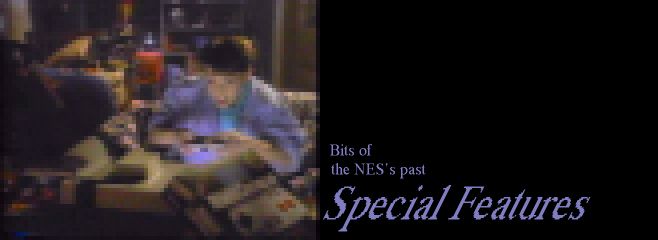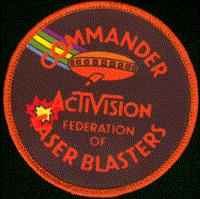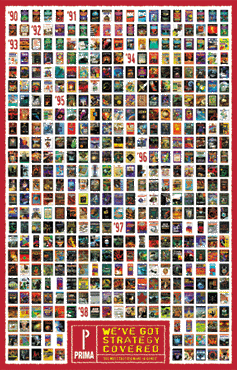
Welcome to the NES interview, a hopefully occasional installment in Special Features. Here we'll interview the people responsible for making the NES - and the video game world - what it is, from programmers to designers to those who found themselves simply swept up in the revolution. In this installment, |tsr interviews Zach Meston, strategy guide author, game magazine writer and current employee of Working Designs. With Rusel DeMaria, Zach either fully wrote or co-wrote most of the books in the Secrets of the Games series for Prima Publishing, including the three Nintendo Games Secrets books. He's got his own web page too, with articles on the seamy underside of the game industry. Q: OK, give me the hard statistics on yourself. A: 26 years old, 6'2", 185 pounds of Soloflex-hardened beefcake. Well, okay, more like 185 pounds of donut-softened thunder-thigh. Single, never married, and never will be because I'm looking for a woman who doesn't exist. (She immensely enjoys videogames, gives and receives great foot massages, and doesn't look like a cross between Chris Farley and Ernest Borgnine. Oh, and she has big breastesess.) Born and raised in Maui, Hawaii; moved to southern California roughly two years ago; moved again to northern California roughly two weeks ago to take a job in game development with Working Designs, the RPG company gamers either love or love to hate. Q: How did you get started with videogames? What were the first things you played?
A: I don't remember my first experience with videogames, but I know I've
always loved them (and technology in general) very dearly. I recall
spending every hour of every weekend in Maui's best two arcades, Tilt and
the wonderfully named Lahaina Galaxy Wars, during the Golden Age of arcade
games (1981 to 1983 B.P.--Before Pubes).
The NES is special to me because I bought it (mine was one of the earliest
units, which included the infamous R.O.B.) right around the time my
hand-eye coordination was sharpening to the point where I could
consistently beat videogames. And, let's be honest, the NES was the first
system with gameplay depth. Almost everything in the Atari 2600 era used a
single unchanging screen and a single repetitive gameplay mechanic. No, I'm
not forgetting stuff like Pitfall! and Adventure; I said ALMOST everything.
Super Mario Bros. was a freaking marvel by comparison. Huge side-scrolling
worlds! Power-ups! Bosses! Ending sequences! Music (insanely repetitive
loops of calliope music that I can still hum in their entirety, but music
nonetheless)! And then came The Legend of Zelda, and Mike Tyson's
Punch-Out, and on and on. I can't tell you how many NES games I played
through in my middle-school years, but easily into the dozens. Q: I take it you got started writing video game stuff via the Nintendo Games Secrets books from Prima. How did you land that job? A: Before I started with Prima, I spent most of 1989 editing and co-writing a fanzine called the Amiga Games Guide. It was devoted entirely to the Commodore Amiga computer, which was, for a time, also the butt-kickin'est game system around. I developed my writing style (which currently sucks, but back then blew chunks) and learned how to call up companies, shmooze PR babes, and scam free games. That's why I got into the fanzine thing in the first place, to be very blunt. I never dreamed I would end up writing strategy guides, or writing for magazines, or eventually working ON games; I simply didn't have enough money to support my gaming habit, and rather than enter the world of X-rated cinema to supplement my paltry income, I took the wimpy approach. The irony, of course, is that I now have more games than I could play in two lifetimes. (And, no, you can't have any. Heh, heh.) Q: (doh)
A: Anyway. During the time I spent toiling on the AGG, I attended monthly
Macintosh user's-group meetings with my partner in crime, Doug Arnold. At
one of those meetings, we met a guy named Rusel DeMaria. Rusel, also a Maui
resident, had been in the game-magazine industry for quite a while, and
he'd just signed a contract with a company named Prima Publishing to launch
a new line of videogame books called Secrets of the Games.
The problem was, Rusel had to churn out FOUR books in a matter of a few
months, and he simply wasn't capable of doing it all himself. (For a
variety of reasons, as I later learned.) Doug suggested to Rusel that
perhaps I could help out, seeing as how I was both a writer and a gamer.
Rusel hooked me up with the NES game Fester's Quest--which I will always
love and cherish, since it broke me into the biz--and asked me to play it,
although I don't think he was particularly confident in my abilities. I
took it home, beat it the same day, wrote up the strategy, and came back to
Rusel's on the weekend to videotape it. He was extremely impressed, and
started assigning me more and more stuff.
It got to the point where I was working literally all day every day--half
the time at my real job at Waldenbooks, the other half playing and writing
about NES games. Exhausted, I told Rusel I couldn't do both. He then
offered to match my salary at the bookstore to work for him full-time. I
agreed in 2.3 nanoseconds, and I've never had a real job since. Well, other
than that brief stint as a crack whore, but let's not go there.
Q: What was Rusel DeMaria like? He was writing for PC Games magazine
at about the same time the Nintendo Games Secrets books came out,
and the writing in that mag isn't exactly awe-inspiring..
Rusel was prone to bizarre mood swings and temper tantrums very unbecoming
of a man (then) in his mid-forties. Example one of Rusel's disk drives
simply refused to work. His frustration grew with each passing moment, the
volume of his profanity climbing higher and higher. Then, amazingly, he
took a deep breath, stood up and walked outside. I thought Rusel had
finally discovered the benefits of calming down. I thought wrong. Rusel
picked up a plastic lawn chair and repeatedly smashed it against the wooden
fence surrounding the yard, leaving hundreds of sharp scraps of white
plastic scattered across the grass. The ultimate insult is that I had to
clean up the mess, since I was the only one who went outside with any
regularity, and didn't want to cut my feet to shreds.
Many people who have worked with Rusel describe him as being a
temperamental asshole, an assessment with which I cannot disagree, and
someone who did quality work, with which I also cannot disagree.
From what I recall, Rusel also wrote for GamePro (when they launched, no
less) and was the editor-in-chief of the short-lived Computer Play
magazine. He made the jump into game development several years back and
formed DeMaria Studios, which to the best of my knowledge has never
produced anything.
A: While I didn't receive an authorship credit on the earliest Nintendo Games
Secrets, about 30% of it was my stuff. (I also didn't receive authorship
billing on Prima's other three line-launching books.) I was credited as
co-author from NGS 2 through NGS 4, but I did the vast majority of the
playing, videotaping, screen-capturing, writing, and editing in all three
volumes, about 15 to 20 games per book. I know this will sound insanely
egotistical, but it is not at all untrue to say that I played a very
crucial part in the early success of Prima Publishing, and I don't think
they would be the industry's dominant strategy-guide publisher without my
contributions. (Which makes me cringe all the more when I see the endless
stream of crappy books they churn out these days.)
Q: How did you get out of writing Prima books?
A: I got out of writing for Prima because my AGG partner, Doug Arnold, had
convinced his mother - who just so happened to own a publishing company - to
let him produce strategy guides of his own. I agreed to work for Doug
because I considered (and still consider) him a friend, because I wanted to
return to Maui (Rusel had moved about an hour away from Prima's northern
California offices), and because I was tired of writing all these books and
not only getting second billing, but - even worse - only getting half the
royalties. Rusel made a LOT of money from my efforts and never once made an
effort to make it a more equitable split of the profits. It pleased me very
greatly to note that Prima had to hire a veritable army of players and
writers when I left.
Q: What was the general process of making these "game collection" style
tip books?
A: Step #1: Figure out which games to write about. The first-party stuff was
obvious anything with Mario or Zelda in the title was in. The third-party
stuff was tougher, because we essentially had to predict which games we
thought would sell the biggest numbers (and this was well before the advent
of the NPS/TRSTS videogame bestseller list). We guessed right maybe half
the time, but every book had games that no one had heard of even back then.
NGS 4, the last NES book I worked on, was the worst in that regard; it was
filler from cover to cover. Gemfire? Darkwing Duck? Infiltrator? You know
your book sucks when Mega Man 4 is the highlight.
Step #2: Scam the games. I'd call up contacts at each game company and beg
and plead for them to send us prerelease versions of their stuff. Some
companies, happy for the coverage, were eager to cooperate; others
questioned the value of helping us tell their customers how to beat their
games faster. But we were almost always able to acquire the games we wanted.
Step #3: Play the games. While I would occasionally play two or three games
concurrently if they had password features, I'd usually focus my efforts on
ripping through one game at a time. And I had to rip through the game at
least twice once to get the feel, a second time to videotape it, and
occasionally a third time to playtest the strategies and check for any
missed secrets.
Step #4: Write the strategies. I'd type very rough notes on the computer
during my first play-through, and write the real chapter while referring to
the videotape of my second play-through. We found out very early on that it
was important to do this while the gameplay and patterns were still fresh
in your head, or you'd have to play the game again. We also found out very
early on that it was impossible to write strategies watching a videotape of
a game you hadn't played, because you didn't understand the gameplay
involved in what you were watching.
(Before and a while after meeting me, Rusel had a "team" of players which
were all children of Rusel's friends, and invariably sucked. See, most
parents think their kids are great at games, but that's only because the
kids are great when compared to their heinously uncoordinated parents. When
put to the test, our "team" would invariably choke--and on the very rare
occasions when they could finish a game, they had no idea how to describe
what they did, meaning I had to play through the game myself anyway.)
Step #5: Take screenshots. This was done in conjunction with #3, using a
Super VHS VCR and a very expensive Macintosh-based capture board with a
VERY loud cooling fan. As time went on, I cut the VCR out of the process,
since it heavily reduced the capture quality, and jacked the NES directly
into the board, using an elbow or big toe to work the keyboard and activate
the "grab" command.
With a few games, I even delved into the realm of creating multi-screenshot
maps, which are by far the least enjoyable aspect of strategy guides. It's
mind-numbing work, and the only way to survive it is to listen to a lot of
rock and roll at extremely loud volumes. (My hearing is definitely not what
it should be at 26, and I'm convinced those long, lonely nights cutting and
pasting together two hundred pictures at a time while Boston's "More Than a
Feeling" reverberated through my head are largely responsible.)
Step #6: Write captions. I never worked on the layout, but I'd have to sit
down when a chapter was laid out and add captions to each shot. My captions
were serious for the first couple books I worked on, but became
progressively sillier (along with the rest of my writing) over time.
Step #7: Proofread. I had to read the entire manuscript cover to cover,
searching for typographical and descriptive errors--you don't wanna tell
someone to run left when he's supposed to run right. Wish I could say
nothing ever got past me, but I was usually so burned out at the end of a
project that I would scan the pages more than read them, which led to
numerous boo-boos finding their way into print.
Q:
How much help did you get from the game companies
themselves? Were you given maps, prerelease carts, or that sort of thing?
Was it done through the publisher, or did you get to communicate directly
with the game's staff? Did you get to keep any of the stuff?
A: The majority of the time, I had assistance from game companies--a
videotape, an internally-written walkthrough, game producers and testers I
can call. Then again, some companies supplied me with almost no help at
all. Those are the books with which I really earned my dinero, because I
had to play and write in a hurry. It was much more personally satisfying
when I figure dout the shit on my own, but writing a strategy guide isn't
about discovery and fun; it's about getting all the info written down as
quickly as possible so I can meet my deadline.
Although game companies always wanted the prerelease carts back, seeing as
how they are righteously expensive, I managed to keep a few. Rusel even got
an empty EPROM of his own so that companies could simply send us ROM chips
of their NES games, which were much cheaper to produce. Lemme tell ya,
nothing is more stressful than prying a set of chips off a semi-fragile
circuit board worth more than your life, then plugging in another set of
chips while trying not to bend any of the two dozen extremely bendable pins.
Q:
Did you try covering unlicensed games? Did Nintendo themselves ever
bother you about the books' content?
A: We never wrote about unlicensed games, but mostly because (with the blessed
exception of Tengen's Tetris) they were awful. Like, remember those Color
Dreams carts? Blecch. I'd rather have written about the joys of splinters
wedged under one's fingernails.
Nintendo never bothered us about the contents of the books, but as we (and
they) entered the 16-bit era, they bothered us about the TITLES of the
books. After Prima released Super Mario World Secrets in 1992, they got
their first-ever letter from Nintendo's lawyer-weasels, pointing out the
various trademarks Nintendo owned and requesting unusual changes in the
phrasing of the books. For example, we couldn't use Nintendo's games as the
subject of a sentence. "Super Mario World made my nipples erect with
excitement" was not allowed; "The Super Mario World video game made my
nipples erect with excitement" was okay.
(The relationship between Prima and Nintendo recently degenerated into
full-fledged legal action; Nintendo came after Prima for their unofficial
GoldenEye 007 book, which Nintendo claimed had maps lifted directly from
Nintendo's own guide. I have both books, and I can tell you that Nintendo
is absolutely right; Prima's maps are BLATANT copies, especially when you
consider that GoldenEye doesn't have an automapping function!
Unfortunately, the idiotic judge in the case sided with Prima's defense
that the maps were public information. Map and atlas producers such as Rand
McNally copyright their maps, and even slip intentional, but very obscure,
errors into them to guard against plagiarism; maybe Nintendo should try a
similar approach.)
[Note: This lawsuit was recently settled, as Prima and NOA have reached a deal
for Prima to publish official strategy guides for Nintendo-made games.]
 Q: Is most of your business these days writing strategy guides, or free lance magazine articles? Is it lucrative, or "for the love" (heh)?
A:
These days, my business is localizing Japanese RPGs and action games, and
writing strategy guides, for Working Designs. It's groovy. Until two weeks
ago, my business was about evenly split between strategy guides and
magazine articles. The strategy guides were for Dimension Publishing, and
the magazine work was mostly for Dimension (PSExtreme, Q64, Voodoo) but
also for a couple other mags, including the retailer publication GameWEEK.
All told, I've written for at least two dozen print, CD-ROM and Web
magazines over the years, which is why I proudly call myself a freelance
weasel.
The payment structure for strategy guides has changed a lot since I worked
on the NGS series, and not for the better. When I did my unofficial books
for Prima, I was paid an advance (usually around the $5,000 mark) and a 15%
royalty. That is to say, I got 15% of the profits--which, depending on the
cover price, could be anywhere from a quarter to almost a dollar per book.
The $5,000 advance was a guaranteed minimum--even if the book never sold a
single copy, I kept the money. If and when the accumulated royalties went
over $5,000, I received additional monies in the form of twice-yearly
payments (usually around May and November). These days, authors usually get
feeble royalties (usually in the 5-7% range) for official guides, and 10%
rates or single-payment flat fees for unofficial guides. Flat fees are a
lose-lose situation for authors If the book sells well, the author doesn't
reap any of the rewards, and if it doesn't, no one knows he exists.
The best-selling books I've ever done were two unofficial Prima books on
SNES games: Super Mario World Game Secrets (half the profits of which I had
to split with "co-author" Rusel DeMaria) and The Legend of Zelda: A Link to
the Past Game Secrets. Both of these books have sold well over 125,000
copies--more unit sales than many videogames, I feel obliged to point
out--which would've left me in a cozy financial state, had my mother not
blown all the dough I made and left me in five-figure debt to our nation's
less-than-understanding tax collectors. (I don't blame my mother for what
she did; it was my fault for allowing her to handle my finances instead of
taking charge myself.)
In the post-Prima era, my books have made only modest cash at best. Even my
most recent publications with Dimension, which have almost all gone over
the 50,000-copy mark, haven't done too much more than pay my rent and allow
me to hire the occasional "escort." Q: What's your personal favorite video memory, and what's the thing you like best about what you do?
A:
My favorite memory...man, there are way too many to count. Seeing my name
in a strategy guide for the first time (the acknowledgements of Nintendo
Games Secrets). Seeing my name in a game manual for the first time
(Sir-tech's Bane of the Cosmic Forge--I did a bit of beta-testing and
manual proofreading). Seeing my name in a videogame for the first time (the
credits of the 3DO game Way of the Warrior--and I didn't even know it was
there until I left the game running one day while talking on the phone, and
saw my name scroll into view, at which point I totally freaked out). Seeing
my writing in a videogame for the first time (Albert Odyssey, a Working
Designs RPG for the Sega Saturn). And, of course, finding World -1 in Super
Mario Bros.
What do I like best about my job? The fact that I can sit down on any given
day and transport myself into another world--and get paid for it. Q: I imagine you get at least a few mails asking how to enter the sort of career in the game bizzz you eked out for yourself. What do you say to them?
A:
Well, seeing as how my path into the industry was an endless series of
lucky breaks, I'm not exactly sure how much advice I'm qualified to give.
In fact, few magazine writers or game developers enter the industry after
setting out to do so; they kind of luck into it like I did. Lack of
knowledge has never stopped me from flapping my gums in the past, of
course, so here goes. Unless you have artistic or programming skills, you
have one of two routes become a magazine writer or become a game tester.
If you prefer the first choice, you can't just call up a videogame magazine
and say "I want to write for you." You need to obtain their writers'
guidelines, send them samples of your writing, et cetera. You can also take
the approach more and more fans are using and start a videogame website. If
your writing is good enough, you'll earn the interest of the prozines and,
if you're REALLY lucky, get to play in the Big Show. (I'll always consider
videogame websites the minors, by the way.)
If testing seems like your bag, baby, keep in mind it will severely test
your love of videogaming, because you will be playing games in their rawest
form, and playing them over and over and over again. Here at Working
Designs, we have people who have played completely through the same game 15
to 20 times, searching for bugs and typos. Even the best game loses its
luster by then, I assure you.
The advantages to being a writer are obvious; tons of free games, flirting
with hot PR babes, being relentlessly butt-kissed by game companies. But
the pay generally sucks unless you're in a high editorial position. The
advantages to being a developer are also obvious; the sheer joy of
creation, flirting with hot babes in the office, being relentlessly
butt-kissed by game magazines who want your advertising. (I can tell you
that while I enjoyed the magazine gig for a long while, I got a little
burned out on it, and am now VERY happy to be on the development side of
things.)
- Thanks for the time, Zach! |




